Space Based Solar Power
According to the ESA (European Space Agency) Space-Based Solar Power is “not only technically feasible, but economically viable”.
Listen to a short Artificial Intelligence (AI) summary of the following article

Solar power for sustainable renewable energy is not a science solution alone: The creation and distribution of electricity requires a business platform and supporting ecosystem to turn scientific theory and space technology into commercial reality.
This page describes the science and a potential Use Case for a space-based solar power distribution network on a distributed ledger technology platform. The page challenges the science behind the use of rooftop solar photovoltaic panels and advocates the use of optical rectennas to harvest light emitted from the sun in a more efficient and environmentally friendly way.
If it can be proven that electromatic waves transmitted to earth with microwave or laser technology, aided by orbiting satellites to enhance the strength, can be harvested to distribute electricity to a global community, the world will not only reach their carbon reduction targets much faster but will have a reliable source of energy for future generations.
At the centre of scientific research, and focus for improvement, is a tiny component called a DIODE: It just might be a game changer.
Introduction
It is time to take a pragmatic approach to renewable energy to address climate change. There are different schools of thought about the right science to apply and whilst some ideas may have merit it is a matter of choosing the right solution for now. That may mean keeping the door open for other solutions to contribute later but for now a choice must be made.
For many reasons the world is not convinced that any one of the current renewable energy sources is the right singular solution to replace fossil fuel. There are five possible solutions at present:
- Wind farms are too intermittent
- Hydrogen is still under development
- Nuclear will take too long to build and will have too many opponents
- Fusion is still under development
- Solar power is dependent on sunlight and lacks 24 hour coverage but is cheap and proven
The most popular commercial solution for today appears to be number 5 in the list above, solar power, and that currently involves the use of solar photovoltaic (PV) panels. Based on the PV panels apparent solution, countries have gone to great lengths to create acres and acres of solar panels on our roofs, in our deserts and even in our oceans. Despite well-known obstacles and short comings, such as dependence on clear and uninterrupted sunlight, damage to the environment and low efficiency rates (18–22%) due to the sun’s light rays passing through the earth’s atmosphere, the solar PV panel option has been adopted and commercialised by many countries around the world.
Solar Power
Actually, there are two options for the use of Solar Power. Solar PV Panels and Optical Rectennas. Both options are subject to transmission through the earth’s atmosphere that degrades the potency of the light beam. The atmosphere contains dust, clouds, moisture, etc. that impacts the sun’s rays. The difference between the two options is the method of harvesting light. The Rooftop Solar PV Panel method is based on the scientific theory that light is a “particle” and the Optical Rectenna method is based on the theory that light is a “wave” (explained further on in this article):
Direct Sunlight Beaming: That is, uninterrupted beam from the sun and harvested by A1. Solar PV Panels (“particle theory”) in the diagram below or the A2. An Optical Rectennas (“Wave theory”) method.

Both solar power harvesting methods use a similar infrastructure to convert the sun’s light beams into electricity. The importance of the common infrastructure components will be explained further on in this article.
Indirect Sunlight Beaming is where the sun’s beam is intercepted by an orbiting satellite, magnified and transmitted to earth by laser or microwave to cut through the earth’s atmosphere and increase the strength of the beam to the same ground receiving points and harvested by B1. Solar PV Panels (“Particle theory”) in the diagram below or B2. Optical Rectennas (“Wave theory”).

Both Direct and Indirect options call for a decentralized network to manage the authenticity of consumers and distribution of power production.
Rooftop Solar Photovoltaic Panels
There is a fundamental problem with solar PV panels. They are designed to treat the sun’s light rays as “particles” and the particles of light interact with atoms in a specially designed “silicon sandwich” to convert photons into electrons and produce electricity, illustrated in the diagram below.
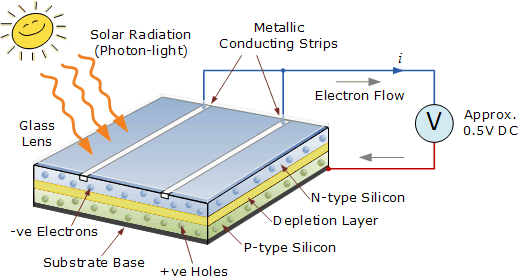
For Direct Sunlight Beaming, the only way to harvest more energy is to build bigger arrays of solar cells to capture the intermittent supply of daylight and there is a reliance on batteries to preserve excess electricity. There will be improvements as research into the materials used to build the solar cells focuses on Perovskite and other materials, but it is an ugly option and environmentally hazardous.
For Indirect Solar Beaming, current initiatives for space based solar power are focused on the Geostationary Orbit and that is not suitable for the decentralized rooftop solar PV panels and microgrid distribution networks. The most common method is to beam to large on-earth arrays, convert the electromagnetic waves into DC electricity for input to the main grid. The diagram below illustrates the model.

The size of the antenna array on earth to harvest energy is influenced by the size of transmitting arrays in space and distance from earth and makes the rooftop solar PV panel NOT a viable solution for global adoption and only suited to the centralised main grid technique. The main advantage is the number of companies working on projects to have a solution within the next decade.
Optical Rectennas
An alternate scientific theory about the sun’s light rays are they are “waves” that can be captured in the same way as radio and television via radio frequency waves. However, not all sections of the electromagnetic spectrum are safe or suitable for solar beaming. The diagram below shows the section of the electromagnetic spectrum that is suitable and that is what makes this option so exciting: It is simple and applies a satellite method to energy collection that is not much different to the method that tracks our location through GPS and enables the use of mobile phones, radio, television and other telecommunications.
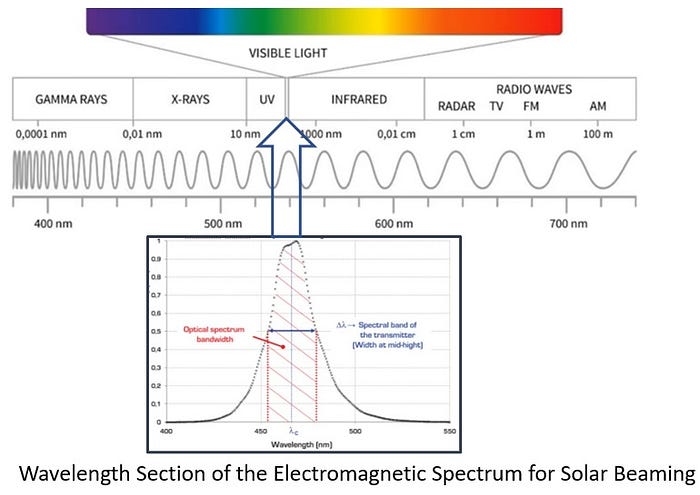
“Optical rectennas” take their name from the visible “optical” section of the electromagnetic spectrum shown in the diagram above.
The wavelength distance will influence the size of the rectenna gain function. Usually, the larger the wavelength the bigger the antenna or rectenna. Retrodirective beaming for reduction in rectenna size and capability to capture light waves is another area of research and likely improvement. The rectenna passing light waves to the rectifier and a diode converts the electromagnetic waves into DC (Direct Current) electricity. Until recently the speed of light entering the rectifier was too much for the diode to process. However, the use of new materials identified by MIM (Metal-Insulator-Metal) studies and quantum tunnelling techniques now make it possible to have a narrow focused beam suitable for rooftop optical rectennas. The diode is only a small component (shown in the diagram below) but it could hold the key for the use of optical rectennas for space based solar power and enable the adoption and delivery of commercially efficient solar power within the next couple of years.

The Science & Technology
The solar PV panel solution is one of two fundamental scientific assumptions related to electricity harvesting and is based on the premise that light generated by the sun is a “particle”. One of the earliest advocates for that theory is Sir Isaac Newton. The other theory is the “wave” theory and that was supported by other scientists, including Albert Einstein.
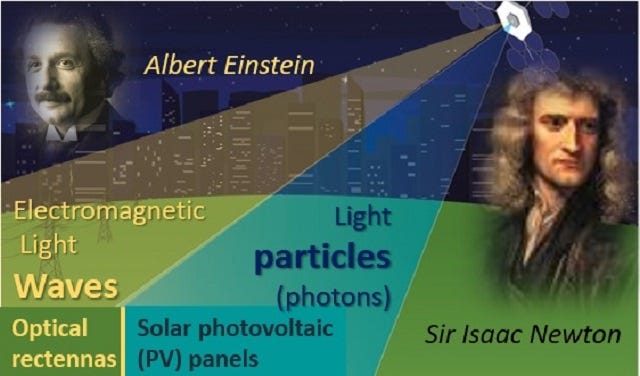
Light is a “Particle” School of Thought
The renowned English physicist, Sir Isaac Newton, advanced the theory in the 18th Century that light was a “particle” and the PV concept is based on that theory.
When the particles hit a silicon panel the electromagnetic forces create havoc for atoms sandwiched between two layers of silicon, glass and metal plates and the result is an oscillating force that converts photons to electrons and produces an electric current. The current is then harnessed by means of wires and coils to produce AC (Asynchronous Current) electricity. The current is transferred to the more usable DC (Direct Current), by means of a rectifier that feeds the electricity into a grid and — presto the lights come on.
The process illustrating what happens within a photovoltaic cell is shown in the diagram below.

The solar PV panel concept has evolved to shared electricity microgrids with remote communities and has applied wireless power transmission methods to distribute electricity. Within cities and major regional hubs poles and wires are used to distribute power from a main grid source to substations, then to consumers where physically possible, and form part of the electricity infrastructure. Remote locations unable to connect to the main grid have the option of becoming “island” microgrids.
Light is a “Wave” School of Thought
There is another theory based on measurable electromagnetic wave lengths within a spectrum. Modern society enjoy the benefits of television, radio and GPS tracking with pocket size devices, enabled through satellite communication using “wave” technology. Light waves can be used for a host of solutions that predict weather, observe earth, navigation for transport, etc. The waves are captured by purpose-built antennas. However, radio frequency waves also transmit energy and that is where it becomes interesting as an alternate method of harvesting light to create power.
It was during the 19th century that the Scottish physicist James Maxwell identified the existence of electromagnetic waves and declared that light was an electromagnetic wave. The particle/wave debate remained a difference in scientific theory and Albert Einstein chimed in later in the 19th century to say light could be a particle and a wave. Einstein’s theory was that light consisted of photon particles packaged as waves.
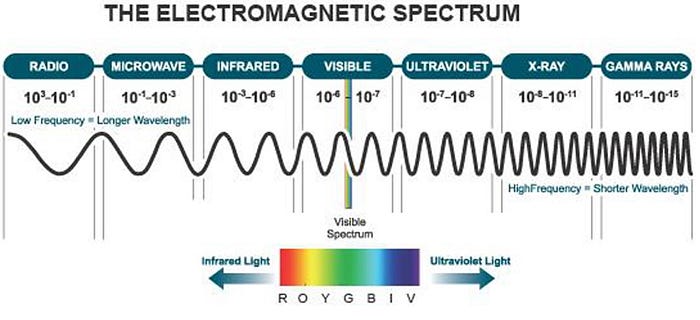
Now the focus is on light waves as a source of energy: To keep it simple, modern science has identified the section of the spectrum that delivers light waves that could be captured and produce electricity. The difference is the type of antenna. The “wave” theorists base their solution on a combined antenna and rectifier called an optical rectenna. The rectifier section contains a diode and that is where the future of wave beamed power gets interesting. The current constraint is the diode response to the speed of light waves entering the rectenna and lack of ability to convert into electricity, mentioned earlier.
Research has focused on the type of metals used in diodes and the ability to capture certain wave lengths and convert to electricity in sufficient quantities to be commercially viable. Aesthetically and environmentally friendly, optical rectennas can be a small arial-like device on the rooftop or close to the electricity conversion infrastructure to transmit, consume, share, deliver to microgrids and store output. That would make solar PV panels redundant, but the conversion to their established infrastructure would be reusable.
The suitability for optical rectennas to be the collection point for satellite microwave or laser beams promises to make it a more commercially suitable and environmentally acceptable option. It won’t be too long before space based solar power beamed to earth to optical rectennas is recognised as the best solution. The Space Energy Initiative describe the urgency for a solution in their video with a focus on space based solar power to slow climate change.
The HR Global Business Platform & Network
Solar PV panels is a scientific solution for the adoption of renewable energy: Not a business solution to the problem. Every solar beaming solution requires a robust network to distribute energy both locally and globally. The diagram below illustrates the central role the ground station network plays in the space-based solar power transmission process.
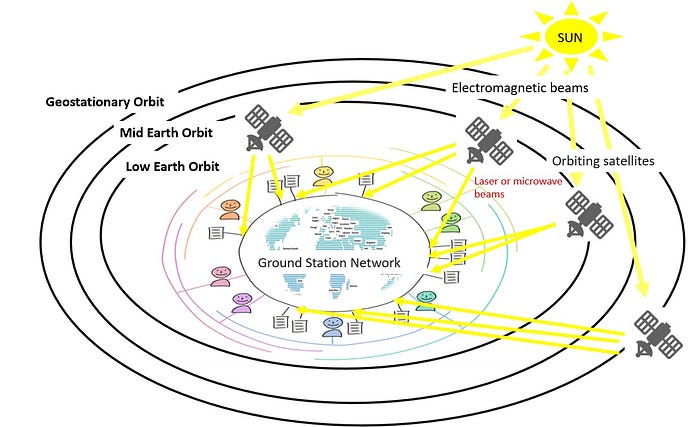
A creditable decentralized ground receiving network, with a recognised governance body in place to set the rules for network membership, is needed for a space-based solar beaming operation and it requires a supporting robust decentralized technology. Current Web2 applications built on a centralized datacentre architecture are not suitable for the new hosting environment.
One of the main requirements in setting up a ground station is the ability to have verified participants in a network and secure control over data privacy. The nature of data is highly sensitive, and it will be necessary to store information such as geolocations for satellite beaming and electricity distribution. Current Web2 platforms are unsuitable. The solution is a distributed ledger technology (DLT) peer-to-peer network running on a Web3 platform for all the decentralised benefits.
Hosting Network Technology
A peer-to-peer Web3 architecture with authenticated agents as hosts, and verified individuals as participants, in distributed ledger network is the right solution.
Plug in applications to address the mass of new use cases is essential. The diagram below illustrates the type of environment that calls for a new approach to developing new enterprise applications.

The Need for Decentralization of Energy Assets
In today’s world any solution must include protection of national energy resources. The most popular space-based solar solutions at present require massive arrays of solar panels deployed in outer space, usually targeting the geostationary orbit. The transmission to earth requires similarly large installations to capture electromagnetic waves to convert into electricity in a terrestrially centralized location. That provides a centralized “point of destruction” in the event of conflict. That is an unacceptable risk to governments.
Whilst the current rooftop photovoltaic panels represent partial decentralization, they are a hybrid solution that includes connection to a main grid in most cases. The ideal solution is total decentralization with many “targets” and that is where the most exciting development is taking place to mitigate risk.
A decentralized method of harvesting energy calls for smaller antennas, called optical rectennas, that can be positioned on rooftops, rather than large arrays of solar panels. The challenge is to build a validated network of energy consumers that will take advantage of the potentially very cheap form of electricity. That is where a common platform emerges: One that is used for workforce data and is built on a peer-to-peer distributed ledger platform with Distributed hash technology (DHT). DHT has evolved from earlier generations of system architecture: DHT is the new blockchain for enterprise applications and enables more flexibility to add functionality and support interoperability.

A recent article published in the International Association for Human Resource Information Management (IHRIM) describes the technology that will emerge over the next decade.
The Scope and Impact of Web3 on HR Systems By John Macy and Dennis Hill, Ph.D.

Quote from IHRIM’s WSR Q1 2022 article: “The Web3 HR platform offers an imminent future consisting of open-source frameworks for modular assembly and composable application development and energy-conscious hosting services for a sustainable future. Current enterprise platforms will be disrupted, and the adoption of new Metaversestyle applications and edge computing devices will render existing applications obsolete…and very quickly.”
Ecosystem impact
The introduction of space-based solar beaming will have an enormous impact on the energy ecosystem as new job are created and whole industries restructured. There will be a need for infrastructure redesign and reskilling of the current energy sector workforce.
Carbon and Electricity Trading
The carbon and electricity marketplace will take on a new form. Harvesting solar energy is not an exact science and is not programable: We have seen in this article scientific theories have varied over the last few centuries and methods of measuring carbon emission would similarly have different opinions. The current method of determining how to measure carbon output is flawed. To introduce a system of allocating carbon emission measurements to industry, and then allow trading of the emissions, makes as much sense as early crypto currency trading. Dealing with the intangible and creating a market to exchange credits will do nothing to reduce carbon emissions: It will only make the speculators richer and industry poorer.
A better method of measuring carbon reduction is to apply thermal measuring technology that is now available and can be part of the satellite community. An example is the SatelliteVu company thermal imaging technique, described in the video https://youtu.be/yCuBMh5E5sQ
The electricity trading market would take on a different shape. At present buying electricity from wholesalers and becoming retail sellers contributes nothing to the energy sector and adds an additional overhead to the cost of electricity to consumers.
Impact on the Satellite Industry
Perhaps the most exciting step in identifying a renewable energy solution is the prospect of simulation and proving the viability of “wave” technology and enhancing the potency of light wave beams by introducing space based solar beaming from orbiting satellites. The beam would be more concentrated, magnified to be stronger, and would relay wave beams intercepted in space to nullify the negative impact of earth’s atmosphere. Once it becomes mainstream renewable energy it will put a greater emphasis on localised satellite industries.
Development of beaming options would start with using low earth orbit (LEO) satellites to receive the same limited coverage delivered by rooftop panels that we use at present. That is, no night coverage and atmospheric interference. However, there is the possibility of using multiple satellites to offset the loss rather than reliance on single satellite delivery. LEO is already home to thousands of satellites and the reduction in launch costs will mean tens of thousands more will find their way into the orbit and create a new industry demand.
The mid earth orbit (MEO) is another option that increases coverage but still does not enable 24 hours per day uninterrupted beaming. There are initiatives using reflected light and multiple satellites but that is really a transition strategy for robot assembly with a view to moving to geostationary orbit later. The geostationary orbit (over 35,000 km from earth) that would allow a satellite positioned in the same spot above earth on a 24 hour orbit cycle and enable continuous beaming. The orbit is currently used for weather and navigation satellites and limited slots are available from regulating bodies. Alternately, there is the geosynchronous orbit (same distance from earth) that would not provide the same certainty of coverage, and may require adjustment from time to time, but would represent a second-best solution.
Reusable Infrastructure and Investment Protection
The most promising aspect of transitioning from solar PV panels to wave capturing optical rectennas is the possibility of using current investment in PV panel infrastructure. It may be as simple as reconnecting the source from the panels to a rectenna with minor modification and plugging into the wiring that takes electricity to the storage and distribution point. Plus, there is a possibility that the same rectenna can become multi-purpose and be used to connect to satellite communication for Edge Computing devices, along with 5G communication.
The diagram below illustrates the components of the solar PV panel architecture used to convert incoming energy source to electricity. Changing the energy source and retaining infrastructure is the subject of a Proof of Concept (PoC) being planned by Competitive Edge Technology (CET) and partners.

Components: Rooftop DC Isolator, Inverter DC Isolator, Solar Inverter, AC Isolator, Switchboard, Consumption Monitor, Grid Meter
Summary
From a space technology viewpoint, the components that need to be proven are:
- Wireless power transmission using ground installations will be the first step in confirming optical rectennas are the right receiving point for electromagnetic wave beaming.
- Future stages will test satellites’ ability to become the right source to deliver industrial strength energy loads to earth.
- If successful, optical rectennas should replace solar PV panels to harvest energy
- Diode research to improve component optical rectenna capability is necessary
- Electromagnetic wavelength will require more research to determine the frequency and gain size to enable narrow beams to be processed by optical rectennas
- The right orbit (geostationary, mid earth or low earth) will need to be established.
From a commercial infrastructure viewpoint:
- Launch costs will need to be determined to ensure commercial viability
- New decentralized peer-to-peer computing platforms will need to be introduced to support energy networks
- The ecosystem impact will need to be assessed to identify areas for reskilling and industry restructuring
- Emerging distributed ledger technology will need to be proven before global implementation to confirm robustness and security.
- A new governance infrastructure will need to be set up to control the agent hosting network for authentication and proven identity of participants
Conclusion
If the Space-Based Solar Power promise can be proven it will open up new clean energy opportunities.
There will be changes to infrastructure for the transition from solar PV panels to optical rectennas, but there will be opportunities to reuse many components. There will be changes to the role of the main grid and current ecosystem.
A worst-case scenario is the concept of space-based solar power using an optical rectenna to harvest energy fails because the technology is not quite ready. If that happens the decentralized business platform would still support the rooftop solar PV panel global deployment to the same audience and the investment in time and resources will not be wasted.
For more information about the benefit of packaging electricity provision as a component of remuneration see the FOOTNOTE in the article Microgrids Powered by Renewable Energy and HR Tech are both Hosted on Web3 Platforms and will solve many Problems
Also see:
Nikola Tesla dreamed of free electricity; what happened?
Solar panels in space could beam continuous energy back to earth
Energy From Space Could Soon Be Beamed Anywhere in the World Using the Space-Based Solar Panel
How Space Lasers Could Soon Beam Clean Power Down To Earth
Scientists are working on new technology that could beam unlimited energy to Earth from space
Microgrids and neighbourhood power sharing set to transform how we use energy
Space-Based Solar Power: The Future Source of Energy?
Caltech Announces Breakthrough $100 Million Gift to Fund Space-based Solar Power Project
